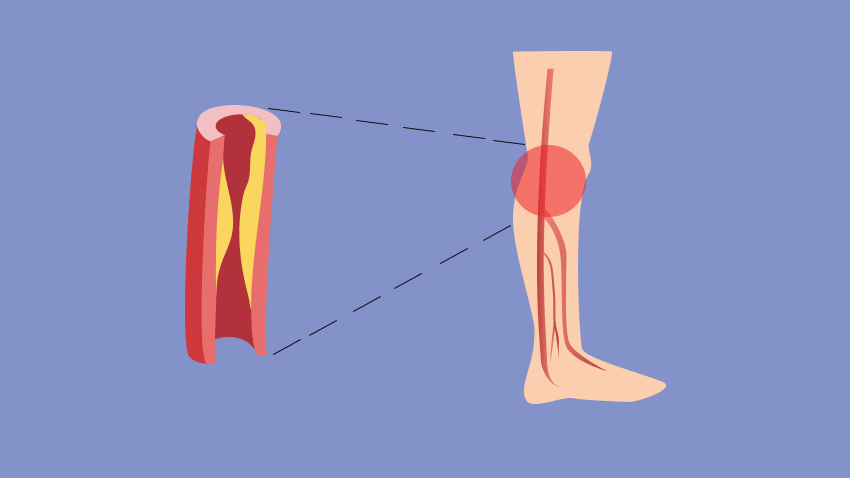September is Peripheral Artery Disease Awareness Month.
The American Heart Association estimates that there are approximately 8.5 million Americans living with Peripheral Artery Disease (PAD). Identifying PAD in yourself or a loved one can be difficult, since symptoms are often attributed to the normal effects of aging or other pre-existing conditions such as arthritis. It’s important to realize, however, that early diagnosis of PAD is essential, since lifestyle changes and medication can often quickly reduce the pain and discomfort of PAD, and drastically decrease the risk for heart attack and stroke. Untreated PAD can be dangerous because it can lead to painful symptoms or loss of a leg, and patients with PAD have an increased risk of coronary artery disease, stroke and heart attack. Because people with PAD have this increased risk for heart attack and stroke, our goal at Cardiovascular Institute of the Shoals is to create an awareness for PAD.

What Is PAD?
PAD is the abbreviation for Peripheral Artery Disease. This disease is a common circulatory problem in which narrowed arteries reduce blood flow to your limbs.
When you develop Peripheral Artery Disease (PAD), usually your legs don’t receive enough blood flow to keep up with the demand that your body needs. This causes symptoms, most noticeably when walking (claudication). PAD is a sign of a more widespread accumulation of fatty deposits in your arteries. This condition may be reducing blood flow to your heart and brain, as well as your legs.
- Mild to Severe Pain in Legs, Especially after Walking
Leg pain while walking is a symptom you do NOT need to ignore. Walking and physical activity, such as walking or climbing stairs, demands an increased supply of blood to the legs. For people with PAD, clogged arteries often make simple physical activities difficult. Pain, weakness, or numbness in the calves, thighs, or hips that disappears after a few minutes of rest is one of the most frequent PAD symptoms reported by patients. In severe or advanced cases, pain might occur while lying down, but most times, simply dangling your feet over the side of the bed will alleviate the pain.
- Changes in the Appearance of Your Legs
Before you start to have pain in your legs there are occasionally other noticeable changes in the appearance of the legs. In some cases, you may find:
- The hair on your legs has thinned or disappeared completely
- Your skin starts to appear shiny
- The growth of your toenails has slowed
- The color of one or both of your legs has changed, taking on a bluish tinge
- Your legs seem colder than other body parts, like your arms
- Sores That Will Not Heal
 Healing, wounds, and fighting infections both require a healthy blood supply therefore injuries must be monitored carefully in patients who are at the risk for PAD. In extreme cases, when you have a wound that becomes neglected, the soft tissue surrounding the wound can die and require amputation. Painful dry, gray, or black sores could be signs of either severe Peripheral Artery Disease or another condition that should be examined by a doctor as soon as possible.
Healing, wounds, and fighting infections both require a healthy blood supply therefore injuries must be monitored carefully in patients who are at the risk for PAD. In extreme cases, when you have a wound that becomes neglected, the soft tissue surrounding the wound can die and require amputation. Painful dry, gray, or black sores could be signs of either severe Peripheral Artery Disease or another condition that should be examined by a doctor as soon as possible.
- When Taking Cold or Allergy Medication Your Symptoms Worsen
Cold and allergy medications that contain pseudoephedrine work by constricting blood vessels and allowing less fluid to enter the sinuses, nose, and throat. This constriction can worsen PAD symptoms by constricting arteries that are already clogged.
- Silent Symptoms
The last symptom is perhaps the most frightening, because there are often no symptoms at all. PAD is a silent killer. In recent studies as many as 75% of patients with Peripheral Artery Disease do not report having any symptoms. In this case, it’s important to understand some of the high risk factors that contribute to PAD, such as:
- Chronic Kidney Disease
- Obesity
- Over the age of 70 or age 50 and older with a history of high blood pressure, high cholesterol, diabetes or smoking
- Family history of PAD, heart attack, or stroke.
If one or more of these factors apply to you, you should ask your doctor about Peripheral Artery Disease and the treatments that are available to you. Call us at (256) 766-2310 or visit our website at www.cardioshoals.com
